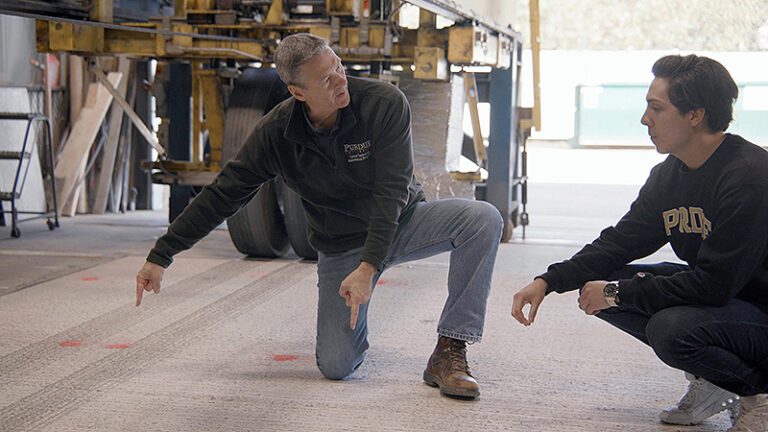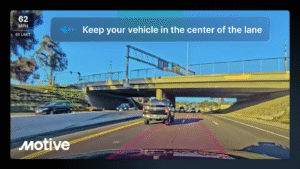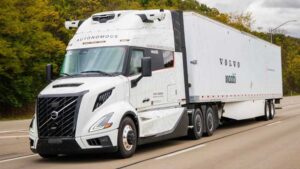WEST LAFAYETTE, Ind. — Purdue University engineers are working alongside the Indiana Department of Transportation (INDOT) to develop a highway that will charge electric vehicles — even 18-wheelers — at highway speeds.
According to a news release from Purdue, construction work began April 1 on a quarter-mile test bed of U.S. Highway 231/U.S. Highway 52 in West Lafayette.
The team will use this bed to gauge how well a patent-pending system designed by Purdue engineers can provide power to a heavy-duty electric truck traveling at highway speeds.
“Thanks once again to some engineers and pioneers from Purdue, we’re developing the world’s first highway test bed for wireless charging,” said Indiana Gov. Eric Holcomb. “Please remember that one. Yes, we will be testing whether concrete can charge passing trucks — and don’t bet against a Purdue Boilermaker.”
The electric truck, provided by Indiana-based company Cummins Inc., will drive over the test bed as part of a pilot program tentatively planned to start next year. The hope is to electrify a section of an Indiana interstate in the next four to five years.
A few other states and countries have also begun testing roads that wirelessly charge electric vehicles (EVs). But making this possible for highways — and heavy-duty trucks in particular — is a unique challenge. Because vehicles travel so much faster on highways than city roads, they need to be charged at higher power levels.
The Purdue-designed wireless charging system is intended to work at power levels much higher than what has been demonstrated in the U.S. so far. By accommodating the higher power needs for heavy-duty vehicles, the design is also able to support the lower power needs of other vehicle classes.
Why design electrified highways for trucks first?
An electrified highway in Indiana would serve much of the nation’s traffic. Eighty percent of the U.S. can be reached within a day’s drive from the state’s pass-through highways.
Building electrified highways with heavy-duty trucks in mind would maximize greenhouse gas reductions and the economic feasibility of developing infrastructure for EVs.
Heavy-duty trucks are one of the biggest sources of greenhouse gas emissions for the U.S. transportation sector because they make up a large portion of interstate traffic. Compared to passenger cars, these trucks also need a lot more fuel so that they can constantly transport everything from the packages we order to groceries.
“The so-called ‘middle mile’ of the supply chain, which refers to all the travel heavy-duty trucks have to do to carry goods from one major location to another, is the most challenging part of the transportation sector to decarbonize,” said Nadia Gkritza, a Purdue professor of civil engineering and agricultural and biological engineering.
But if electric heavy-duty trucks could charge or maintain their state-of-charge using highways, their batteries could be smaller in size and they could carry more cargo, significantly reducing the costs of using EVs for freight transportation. Since trucking contributes the most to U.S. gross domestic product compared to other modes of freight transportation, lowering costs for heavy-duty electric trucks could help attract more investment into electrifying highways that all vehicle classes would share.
“We’re developing a system that has the power to charge semitractor-trailers as they move 65 miles per hour down the road,” John Haddock, a professor in Purdue’s Lyles School of Civil Engineering, told U.S. News & World Report.
Professor John Haddock and graduate student Oscar Moncada examine a slab of concrete pavement they tested to handle heavy truckloads with wireless power-transfer technology installed below the surface. The machine behind them is designed to imitate those loads by repeatedly passing half a loaded semi-truck axle across the concrete slab. (Photo provided by Consensus Digital Media) Download image
Highways that charge EVs like a smartphone
The technology Purdue is developing would enable highway pavement to provide power to EVs similarly to how newer smartphones use magnetic fields to wirelessly charge when placed on a pad.
“If you have a cellphone and you place it on a charger, there is what’s called magnetic fields that are coming up from the charger into that phone. We’re doing something similar. The only thing that’s different is the power levels are higher and you’re going out across a large distance from the roadway to the vehicle,” said Steve Pekarek, Purdue’s Edmund O. Schweitzer, III Professor of Electrical and Computer Engineering, in an episode of “American Innovators,” a Made in America series by Consensus Digital Media. “This is a simple solution. There are complicated parts of it, and that we leave to the vehicle manufacturers.”
In the wireless charging system that Purdue researchers have designed, transmitter coils would be installed in specially dedicated lanes underneath normal concrete pavement and send power to receiver coils attached to the underside of a vehicle.
Other wireless EV charging efforts are also using transmitter and receiver coils, but they haven’t been designed for the higher power levels that heavy-duty trucks need. The Purdue-designed coils accommodate a wider power range — larger vehicles wouldn’t need multiple low-power receiver coils on the trailer to charge from the road, which has been proposed to meet the high-power demands. Instead, in the Purdue design, a single receiver coil assembly is placed under the tractor, greatly simplifying the overall system.
Purdue researchers have also designed the transmitter coils to work within concrete pavement, which makes up 20% of the U.S. interstate system. Other coil designs have only been developed for use in asphalt pavement.
“The whole idea is if you can charge your car on the road while in motion, then you’re basically riding for free,” Aaron Brovont, a Purdue research assistant professor in Purdue’s Elmore Family School of Electrical and Computer Engineering, explained in a Scripps news segment.
In a Purdue electrical engineering lab, Steve Pekarek (left), Aaron Brovont and Dionysios Aliprantis measure the electromagnetic performance of coils they are developing to transmit power to receiver coils on electric vehicles as they drive. (Photo provided by Consensus Digital Media) Download image
The team has completed testing of how well 20-foot-long sections of concrete and asphalt could handle heavy loads with the transmitter coils embedded. The researchers imitated truck traffic by having a machine repeatedly drive a loaded one-half semi axle over the pavements.
Alongside the pavement mechanical tests, the team has also done lab tests verifying the electromagnetic performance of the bare transmitter coils and the receiver coils.
Laying the groundwork for highways that recharge EVs everywhere
As reported by The New York Times, CNBC, Scripps, Popular Mechanics and other news outlets, the research has the potential to define what EV charging looks like on highways.
The team’s partnerships are not just in Indiana, but also throughout the country. In addition to its funding from INDOT through the Joint Transportation Research Program at Purdue, the project is affiliated with a fourth-generation National Science Foundation Engineering Research Center called Advancing Sustainability through Powered Infrastructure for Roadway Electrification (ASPIRE), dedicated to progressing the field of electrified transportation in all its forms.
Most real-world deployments of wireless pavement charging in the U.S. are led by members of ASPIRE. Purdue is a founding member of ASPIRE and Gkritza is the campus director of ASPIRE’s Purdue location.
Headquartered at Utah State University, ASPIRE integrates academia, scientific research, and real-world tests and deployments across more than 400 members from 10 partner universities: Purdue, the University of Colorado Boulder, the University of Texas at El Paso, the University of Auckland in New Zealand, Colorado State University, the University of Colorado Colorado Springs, Virginia Tech, Cornell University and the University of Utah.
These universities are joined by more than 60 industry, government and nonprofit members across all sections of the electric transportation ecosystem, as well as community partners and advisors.
ASPIRE’s members at Purdue and Cummins are also leading a project funded by the U.S. Department of Energy to develop an EV charging and hydrogen fueling plan for medium-duty and heavy-duty trucks on the Midwest’s Interstate 80 corridor. The corridor serves Indiana, Illinois and Ohio. The plan will examine the use of the wireless power transfer technology that Gkritza and her team are testing in West Lafayette.
“We don’t envision 100% of the roads being electrified,” Gkritza said in an episode of “Resources Radio,” a podcast by Washington, D.C., research institution Resources for the Future. “But we see the potential for dynamic wireless power pavement technology as complementary to an expanding network of EV charging stations that we will see very soon here in the U.S. We feel it would be useful in areas where charging stations are scarce in underserved communities, even supporting transit routes where initial charging at the depots and terminal stations might not be enough and there might need to be some charging in between the routes.”
The researchers anticipate that it may be 20 to 30 years before EVs can receive the full power they need while driving at highway speeds. It is up to EV manufacturers to decide whether to incorporate receiver coils into their vehicles.
“The technical obstacles that we need to overcome are not insurmountable. Those can be overcome with proper design,” Dionysios Aliprantis, a Purdue electrical and computer engineering professor, told The New York Times.
The team hopes that the results of their experiments could help convince the industry that electrified highways could work.
“We are Purdue University, where the difficult is done today and the impossible takes a bit longer,” Haddock said.
The Trucker News Staff produces engaging content for not only TheTrucker.com, but also The Trucker Newspaper, which has been serving the trucking industry for more than 30 years. With a focus on drivers, the Trucker News Staff aims to provide relevant, objective content pertaining to the trucking segment of the transportation industry. The Trucker News Staff is based in Little Rock, Arkansas.














